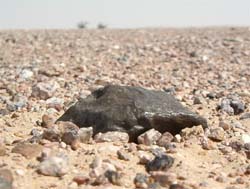
Scientists from the CAS Purple Mountain Observatory (PMO) have found solid evidence that SaU 300, a lunar meteorite discovered in 2004 from the Oman desert, was originated from the far side of the Moon, the lunar hemisphere that is permanently turned away from the Earth where astronauts have not yet set foot.
Lunar meteorites, or lunaites, are rocks found on the Earth that were ejected from the Moon by impacts of meteoroid or possibly comets. They are the rarest substances on the Earth as they only account for 0.1% of all meteorites we have found. They are also very important rocks that could provide vital information about the chemical nature and evolution of the Moon.
Remote sensing surveys in recent years show an extremely irregular pattern of element distribution on the lunar surface. The near side, the hemisphere that permanently turned towards the Earth, is rich in iron and some trace elements such as thorium whereas the far side is not.
A total of 382 kg lunar rocks or regolith were collected by the Apollo missions and former Soviet Lunar projects during the 1970s. These samples were taken from a restricted area on the near side of the Moon within and around the lunar equator. This region was later proven to be geochemical anomalous. Getting samples from the far side of the Moon has been a long-term wish for scientists around the world.
Collaborating with colleagues from US and Germany, Prof. Hsu Weibiao and Dr. ZHANG Aicheng from the Lunar and Planetary Science Center, PMO have carried out a systematic investigation on SaU 300 including mineralogy, petrology, rare-earth elements geochemistry, and bulk-rock composition analysis. As reported in a recent issue of
Meteoritics and Planetary Science, they found that SaU 300 does not contain any KREEPy and mare basaltic components, the rocks mainly found on the near side of the Moon. SaU 300 is also depleted in thorium and other trace elements. The results made them believe that this rock is probably from the farside of the Moon.
A few lunar meteorites have been found during explorations in hot deserts and the Antarctica. Some scholars have previously reported meteorites from the far side of the Moon might exist in our collection, but the controversy remains. It is very difficult to provide evidence which could convince people that a meteorite is from the far side of the Moon.
Studies on lunar meteorites have a significant impact on China's lunar exploration mission. It could help us to better understand of the global feature of the Moon, provide indispensable scientific ground truths for fulfillment of the mission's preset targets and experimental tasks, select landing sites and the orbiter's pay-load, and design sample-collecting plan.







